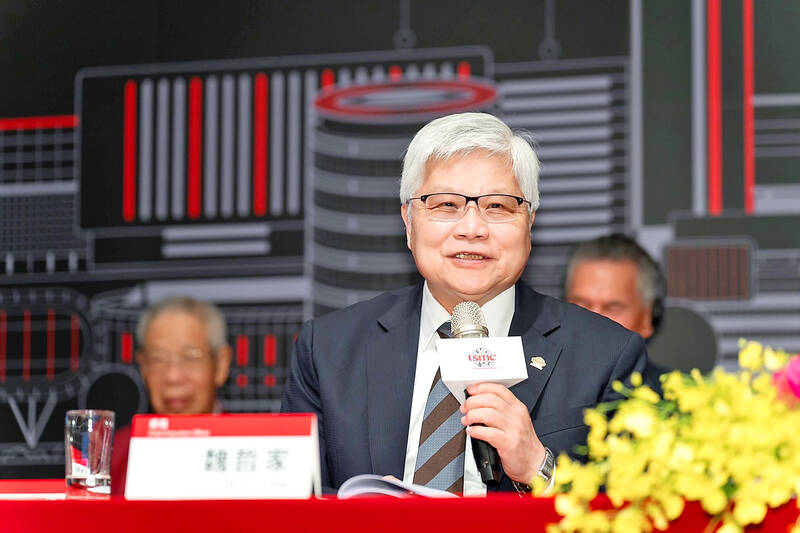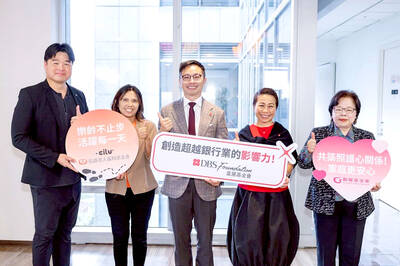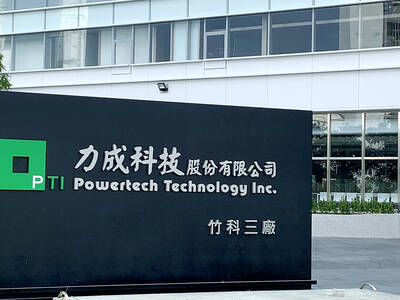Taiwan Semiconductor Manufacturing Co (TSMC, 台積電), the world’s biggest contract chipmaker, yesterday raised its revenue forecast to annual growth of 30 percent this year, thanks to strong and sustainable demand for artificial intelligence (AI) processors for servers.
It was the second upward adjustment from 25 percent year-on-year growth estimated three months ago, despite recent concerns about whether the AI boom could be another technology bubble.
“The demand is real. It’s real. And I believe it is just the beginning of this demand. Alright, so one of my key customers said the demand right now is ‘insane,’” TSMC chairman and chief executive C.C. Wei (魏哲家) said in response to an investor’s question yesterday, citing Nvidia Corp chief executive Jensen Huang’s (黃仁勳) comments about demand for the company’s newest Blackwell AI chips.

Photo: Grace Hung, Taipei Times
“It’s just the beginning ... and it will continue for many years,” Wei said.
Building on such strong growth momentum, TSMC expects to enjoy healthy growth over the next five years due to AI-related applications, Wei said.
That has reflected robust demand for TSMC’s next-generation technologies.
“We have many, many customers interested in 2-nanometer technology,” Wei said.
“We are, actually, seeing more demand than we have ever dreamed about compared with 3-nanometer. So we have to prepare more capacity for 2-nanometer than 3-nanometer,” he said.
That would be followed by A16 technology, Wei said.
A16 is “very, very attractive for the AI server chips and so, actually, demand is also very high,” he said.
The volume production of 2-nanometer technology is to start next year and production of A16 technology is scheduled for the second half of 2026, according to TSMC’s technology road map.
When asked if TSMC would consider acquiring chip manufacturing facilities from Intel Corp after the US firm spun off its foundry business, Wei said his company was not interested.
The firm is seeing “extremely robust AI-related demand from our customers throughout the second half of 2024,” leading to higher capacity utilization of its 3-nanometer and 5-nanometer process technologies, Wei said.
As a result, revenue contribution from server AI processors is to more than triple this year and account for about 15 percent of TSMC’s revenue, Wei said.
Overall, wafer revenue is to grow about 30 percent year-on-year this year in US dollar terms, he said.
TSMC expects its capital spending to be slightly above US$30 billion this year and spending next year might go up from that record-high level, given the robust demand outlook, the chipmaker said.
Revenue this quarter is expected to be between US$26.1 billion and US$26.9 billion, representing quarterly growth of 13 percent or an annual expansion of 35 percent.
Gross margin is expected to range between 57 percent and 59 percent this quarter, compared with 57.8 percent last quarter and 53 percent in the fourth quarter of last year, the firm said.
TSMC yesterday posted the strongest quarterly net income in the company’s history.
Net income surged 31.2 percent quarter-on-quarter to NT$325.26 billion (US$10.11 billion) from NT$247.85 billion.
That represented annual growth of 54.2 percent from NT$211 billion.
Earnings per share rose to NT$12.54, from NT$9.56 in the second quarter and NT$8.14 in the third quarter last year.
Gross margin surpassed the company’s estimate of 55.5 percent.
Revenue last quarter rose to US$23.5 billion, better than its estimate of US$23.2 billion.

The DBS Foundation yesterday announced the launch of two flagship programs, “Silver Motion” and “Happier Caregiver, Healthier Seniors,” in partnership with CCILU Ltd, Hondao Senior Citizens’ Welfare Foundation and the Garden of Hope Foundation to help Taiwan face the challenges of a rapidly aging population. The foundation said it would invest S$4.91 million (US$3.8 million) over three years to foster inclusion and resilience in an aging society. “Aging may bring challenges, but it also brings opportunities. With many Asian markets rapidly becoming super-aged, the DBS Foundation is working with a regional ecosystem of like-minded partners across the private, public and people sectors

BREAKTHROUGH TECH: Powertech expects its fan-out PLP system to become mainstream, saying it can offer three-times greater production throughput Chip packaging service provider Powertech Technology Inc (力成科技) plans to more than double its capital expenditures next year to more than NT$40 billion (US$1.31 billion) as demand for its new panel-level packaging (PLP) technology, primarily used in chips for artificial intelligence (AI) applications, has greatly exceeded what it can supply. A significant portion of the budget, about US$1 billion, would be earmarked for fan-out PLP technology, Powertech told investors yesterday. Its heavy investment in fan-out PLP technology over the past 10 years is expected to bear fruit in 2027 after the technology enters volume production, it said, adding that the tech would

YEAR-END BOOST: The holiday shopping season in the US and Europe, combined with rising demand for AI applications, is expected to drive exports to a new high, the NDC said Taiwan’s business climate monitor improved last month, transitioning from steady growth for the first time in five months, as robust global demand for artificial intelligence (AI) products and new iPhone shipments boosted exports and corporate sales, the National Development Council (NDC) said yesterday. The council uses a five-color system to measure the nation’s economic state, with “green” indicating steady growth, “red” suggesting a boom and “blue” reflecting a recession. “Yellow-red” and “yellow-blue” suggest a transition to a stronger or weaker condition. The total score of the monitor’s composite index rose to 35 points from a revised 31 in August, ending a four-month

RUN IT BACK: A succesful first project working with hyperscalers to design chips encouraged MediaTek to start a second project, aiming to hit stride in 2028 MediaTek Inc (聯發科), the world’s biggest smartphone chip supplier, yesterday said it is engaging a second hyperscaler to help design artificial intelligence (AI) accelerators used in data centers following a similar project expected to generate revenue streams soon. The first AI accelerator project is to bring in US$1 billion revenue next year and several billion US dollars more in 2027, MediaTek chief executive officer Rick Tsai (蔡力行) told a virtual investor conference yesterday. The second AI accelerator project is expected to contribute to revenue beginning in 2028, Tsai said. MediaTek yesterday raised its revenue forecast for the global AI accelerator used